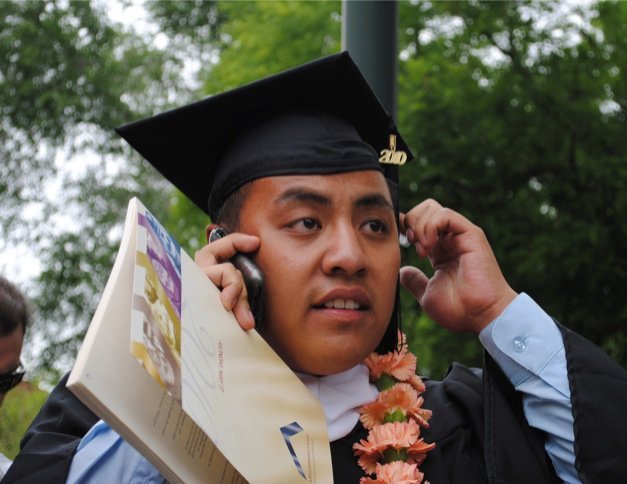Yesterday, my mom, with the help of my aunt and uncle, threw me a family graduation party - and if you're Filipino or have been to Filipino functions, you know what they're like. Lots of food (probably enough to feed three times the number of actual guests), little kids running around, the grandparents and aunts sitting in the corner gossiping about everyone else in the family, the uncles out back drinking San Mig(or in yesterday's case, Red Horse and Corona), and everyone that can sing (or think that they can sing) gathered around the television doing some good old fashioned karaoke. And yes, every Filipino family has a karaoke machine of some sort.
What I never realized before was how much work actually went into planning these get-togethers. My mom and I never really threw any of these parties ourselves. This was just a special occasion since I had just graduated from college and I thought it would be fun to invite the whole family over. I mean, we would usually go to at least 8 or 10 of these things a year, from weddings and baptisms, graduations and holidays, to birthdays and funerals, family parties for Filipinos (or at least for my large extended family) are common place. So naively, I thought they were easy to make happen. Little did I know about the six hour grocery store trips, borrowing tables and chairs and grills from family and friends, cleaning (before and after), chopping up all the vegetables and prepping the meat good enough to feed 50-60 people. It literally took most of Thursday, all of Friday, and Saturday morning (starting at 7am) to prepare for the party at 3pm, and all of Sunday to clean everything up. All in all, it was an exhausting week and I don't think I'd ever want to throw another family party ever again - I don't know how the rest of my family does it a few times every year. I admire them a lot more for it now that I've gone through it myself.
Through it all though, I spent a lot of time talking to my aunt and uncle and my mom, learning about their pasts, finding out about our family history, and most relevantly for the summer project that this post is introducing, discovering age-old culinary secrets that have been passed down to my mom and her sisters from my grandmother, who probably got them from her mother before her - and so I probably won't be revealing any of those secrets in this blog this summer.
What I will be talking about is the experience of rediscovering my culture and family history through cooking Filipino food. While growing up in California, I never really took much of an interest in learning about how to cook Filipino food or learning about my culture in general. Though I could speak Tagalog and lived with my grandmother, who has already passed away, I never took advantage of her memories and the knowledge she could give me about myself and my culture. When I entered college at Penn in September of 2006 (ah, how time has flown), I still had no interest in doing anything Filipino, but through some random twist of fate - one of my hall mates thought it would be funny to write my email down on the PPA (Penn Philippine Association) listserve - I found myself deciding to attend one meeting and remained involved ever since participating in our cultural shows and making a large group of close Filipino friends.
Last summer, I finally went back to the Philippines after 15 years. I spent the whole summer there on an internship at the US Embassy in Manila and though I hadn't been back in forever, it felt completely natural. A large part of me felt very at home in this land which in many ways should have been very foreign. Something inside me resonated with everything that was around me, and this something is driving me now to pursue a greater understanding of and appreciation for my culture and history that I can learn from my family. And this summer, I plan on taking advantage of all my opportunities to do so.
Thus, my summer project and the title of this blog. "Laman Loob" refers to the innards of animals (like the liver, the intestines, kidneys and what-not) used in many Filipino dishes. Literally, it simply means "the stuff inside." This summer, I will attempt to learn and (hopefully) master a variety of Filipino dishes, finding out about my culture, family, and, ultimately, about "the stuff inside" of me.
